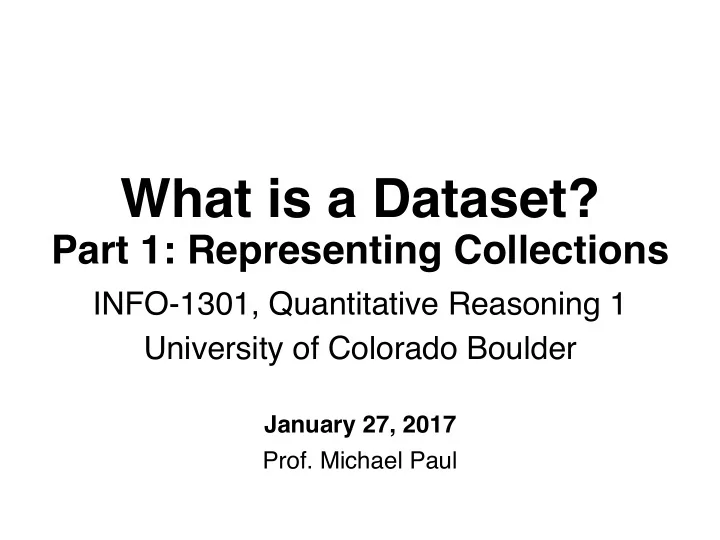

What is a Dataset? Part 1: Representing Collections INFO-1301, Quantitative Reasoning 1 University of Colorado Boulder January 27, 2017 Prof. Michael Paul
Overview This lecture will… • introduce and review some terminology for describing data collections: • matrices, vectors, sets; • present concepts for describing sets. Today’s material is necessary to discuss upcoming concepts (sampling and probability)
Representation of data: matrix • Each row is an observation Name Gender Age (years) Height (cm) # of children Rows John Male 32 179.2 2 Mary Female 49 168.5 4 Alice Female 25 175.0 0 Columns • Each column is a variable Cells • Each cell is a value
Vectors Another term for rows and columns: vectors • Each row is a vector • Each column is a vector
Vectors A vector is a list of values Notation: <179.2, 168.5, 175.0> <John, Male, 32, 179.2, 2> The order matters! • Not equivalent: • <168.5, 179.2, 175.0> • <179.2, 168.5, 175.0>
Matrices A matrix consists of… • One vector for every variable (column) • One vector for every observation/case (row)
Refresher: Domains Reminder from last week: The set of values a variable can take is called the domain of the variable A domain is defined by a set • A set is a collection of values Examples: • Set of genders • Set of dog breeds • Set of integers • Set of real numbers
Sets A set is a collection of values called elements Notation: {1, 2, 3, 4, 5} {red, blue, green} What about ordinal values? The order doesn’t matter! Ordinal values are also represented as sets. The • These sets are equivalent: ordering might matter when it comes time to interpret the • “Integers from 1 to 5” values, but it doesn’t matter • {1, 2, 3, 4, 5} for describing the set of • {5, 3, 2, 1, 4} possible values.
Sets The elements in a set are unique (no duplicates) • {1, 2, 3, 3, 3, 4, 5} is not a valid set The number of different elements in a set is called the cardinality of the set • Also called the order , but we’ll avoid that in this class • Denoted with vertical lines: | | What is the cardinality of • Example: {red, green, blue} the set of integers? • Cardinality = 3 The set of real numbers?
Subsets If every element in a set is also part of another set, then the set is called a subset A = {red, green, blue, yellow} |A| = 4 B = {red, blue} |B| = 2 B ⊂ A B is a subset of A A ⊄ B A is not a subset of B
Empty set A set with no elements is called the empty set • The cardinality of the empty set is 0 Notation: { } Example: Set of dinosaurs that are alive today
Where do we find sets? • Domains of variables are sets • Collections of observations/cases can be described as sets Set of observations: ,, { } • The elements of this set are vectors
Where do we find sets? Matrices vs sets of observations: • Set of people: we don’t care about the order of John, Mary, and Alice • Data matrix: we have organized the people into rows with a specified order • Often we don’t really care about the order, but we need to decide on an order anyway so that we can refer to each row by its number (e.g., “row 15”). Confusingly, a dataset (or data set ) usually refers to a data matrix, which is not a set
Visualizing sets Sets and relationships between sets can be visualized with Venn diagrams John Venn, 1834-1923
Set operations How do we describe the relationship between sets? How do we modify sets? In arithmetic, we have operations such as addition and multiplication • What kind of operations exist for sets? • Union • Intersection • Complement • Difference
Recommend
More recommend